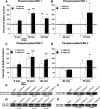Epac activation initiates associative odor preference memories in the rat pup
- PMID: 25593293
- PMCID: PMC4341366
- DOI: 10.1101/lm.037101.114
Epac activation initiates associative odor preference memories in the rat pup
Abstract
Here we examine the role of the exchange protein directly activated by cAMP (Epac) in β-adrenergic-dependent associative odor preference learning in rat pups. Bulbar Epac agonist (8-pCPT-2-O-Me-cAMP, or 8-pCPT) infusions, paired with odor, initiated preference learning, which was selective for the paired odor. Interestingly, pairing odor with Epac activation produced both short-term (STM) and long-term (LTM) odor preference memories. Training using β-adrenergic-activation paired with odor recruited rapid and transient ERK phosphorylation consistent with a role for Epac activation in normal learning. An ERK antagonist prevented intermediate-term memory (ITM) and LTM, but not STM. Epac agonist infusions induced ERK phosphorylation in the mitral cell layer, in the inner half of the dendritic external plexiform layer, in the glomeruli and, patchily, among granule cells. Increased CREB phosphorylation in the mitral and granule cell layers was also seen. Simultaneous blockade of both ERK and CREB pathways prevented any long-term β-adrenergic activated odor preference memory, while LTM deficits associated with blocking only one pathway were prevented by stronger β-adrenergic activation. These results suggest that Epac and PKA play parallel and independent, as well as likely synergistic, roles in creating cAMP-dependent associative memory in rat pups. They further implicate a novel ERK-independent pathway in the mediation of STM by Epac.
© 2015 Grimes et al.; Published by Cold Spring Harbor Laboratory Press.
Figures




Similar articles
-
PKA increases in the olfactory bulb act as unconditioned stimuli and provide evidence for parallel memory systems: pairing odor with increased PKA creates intermediate- and long-term, but not short-term, memories.Learn Mem. 2012 Feb 21;19(3):107-15. doi: 10.1101/lm.024489.111. Learn Mem. 2012. PMID: 22354948
-
CaMKII mediates stimulus specificity in early odor preference learning in rats.J Neurophysiol. 2016 Aug 1;116(2):404-10. doi: 10.1152/jn.00176.2016. Epub 2016 Apr 27. J Neurophysiol. 2016. PMID: 27121578 Free PMC article.
-
pCREB in the neonate rat olfactory bulb is selectively and transiently increased by odor preference-conditioned training.Learn Mem. 1999 Nov-Dec;6(6):608-18. doi: 10.1101/lm.6.6.608. Learn Mem. 1999. PMID: 10641765 Free PMC article.
-
Olfactory bulb glomerular NMDA receptors mediate olfactory nerve potentiation and odor preference learning in the neonate rat.PLoS One. 2012;7(4):e35024. doi: 10.1371/journal.pone.0035024. Epub 2012 Apr 4. PLoS One. 2012. PMID: 22496886 Free PMC article.
-
Exchange protein directly activated by cAMP (epac): a multidomain cAMP mediator in the regulation of diverse biological functions.Pharmacol Rev. 2013 Feb 27;65(2):670-709. doi: 10.1124/pr.110.003707. Print 2013 Apr. Pharmacol Rev. 2013. PMID: 23447132 Review.
Cited by
-
Current Limitations and Candidate Potential of 5-HT7 Receptor Antagonism in Psychiatric Pharmacotherapy.Front Psychiatry. 2021 Feb 18;12:623684. doi: 10.3389/fpsyt.2021.623684. eCollection 2021. Front Psychiatry. 2021. PMID: 33679481 Free PMC article. Review.
-
cAMP Response Element-Binding Protein (CREB): A Possible Signaling Molecule Link in the Pathophysiology of Schizophrenia.Front Mol Neurosci. 2018 Aug 30;11:255. doi: 10.3389/fnmol.2018.00255. eCollection 2018. Front Mol Neurosci. 2018. PMID: 30214393 Free PMC article. Review.
-
Yuk-Gunja-Tang attenuates neuronal death and memory impairment via ERK/CREB/BDNF signaling in the hippocampi of experimental Alzheimer's disease model.Front Pharmacol. 2022 Oct 26;13:1014840. doi: 10.3389/fphar.2022.1014840. eCollection 2022. Front Pharmacol. 2022. PMID: 36386241 Free PMC article.
-
Noradrenergic stabilization of heterosynaptic LTP requires activation of Epac in the hippocampus.Learn Mem. 2019 Jan 16;26(2):31-38. doi: 10.1101/lm.048660.118. Print 2019 Feb. Learn Mem. 2019. PMID: 30651375 Free PMC article.
-
Pyruvate Upregulates Hepatic FGF21 Expression by Activating PDE and Inhibiting cAMP-Epac-CREB Signaling Pathway.Int J Mol Sci. 2022 May 14;23(10):5490. doi: 10.3390/ijms23105490. Int J Mol Sci. 2022. PMID: 35628302 Free PMC article.
References
-
- Aflaki M, Qi XY, Xiao L, Ordog B, Tadevosyan A, Luo X, Maguy A, Shi Y, Tardif JC, Nattel S 2014. Exchange protein directly activated by cAMP mediates slow delayed-rectifier current remodeling by sustained β-adrenergic activation in guinea pig hearts. Circ Res 114: 993–1003. - PubMed
-
- Alberini CM 1999. Genes to remember. J Exp Biol 202: 2887–2891. - PubMed
-
- Attramadal H, Arriza JL, Aoki C, Dawson TM, Codina J, Kwatra MM, Snyder SH, Caron MG, Lefkowitz RJ 1992. β-arrestin2, a novel member of the arrestin/β-arrestin gene family. J Biol Chem 267: 17882–17890. - PubMed
Publication types
MeSH terms
Substances
Grants and funding
LinkOut - more resources
Full Text Sources
Other Literature Sources
Medical
Miscellaneous
